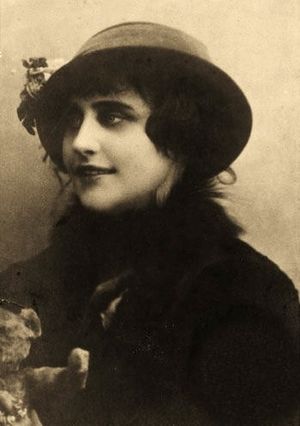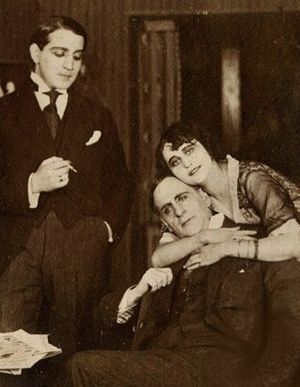Vera Kholodnaya facts for kids
Quick facts for kids
Vera Vasilyevna Kholodnaya
Вера Васильевна Холодная |
|
|---|---|
 |
|
| Born |
Vera Vasilyevna Levchenko
5 August 1893 Poltava, Russian Empire
|
| Died | 16 February 1919 (aged 25) Odessa, Ukrainian People's Republic
|
| Occupation | Actress |
| Years active | 1914–1918 |
| Spouse(s) |
Vladimir Kholodny
(m. 1910) |
| Children | 2 |
Vera Vasilyevna Kholodnaya (born Levchenko; Russian: Вера Васильевна Холодная; Ukrainian: Віра Василівна Холодна; August 5, 1893 – February 16, 1919) was a famous actress from the Russian Empire. She was the very first big star of Russian silent movies. We only have five of her films left today, but she acted in many more – some people think it was between 50 and 100 movies!
Contents
Vera's Early Life
Vera was born in Poltava, which was part of the Russian Empire and is now in Ukraine. When she was just two years old, she moved to Moscow to live with her grandmother. As a young girl, Vera dreamed of becoming a classical ballet dancer. She even joined the ballet school at the famous Bolshoi Theatre. From a very young age, Vera loved to act in family plays. When she was ten, she went to a well-known school called Perepelkina's grammar school.
Her Family Life
At her graduation party, Vera met Vladimir Kholodny. He was a student, an editor for a sports newspaper, and a race-car driver. People say he was one of the first car racers in Russia! Vera and Vladimir got married in 1910, even though their families didn't approve. Vera often went with him to his races, which sometimes led to car accidents. She took his last name, Kholodny, which means "the cold one." Later, many people thought this was a cool stage name she chose herself. Their daughter, Evgeniya, was born in 1912, and they adopted another girl named Nata a year later.
Becoming a Movie Star
In 1908, Vera watched a play called Francesca da Rimini. The main actress, Vera Komissarzhevskaya, really impressed her. This made Vera decide she wanted to try acting in films. She met Vladimir Gardin, a top Russian film director, who gave her a small part in his big movie, Anna Karenina.
In 1915, a director named Yevgeni Bauer was planning a mystical love story film called Song of Triumphant Love. He needed an actress who was incredibly beautiful. When Vera Kholodnaya was introduced to Bauer, he was so amazed by her beauty that he immediately chose her for the role.
Song of Triumphant Love was a huge hit! Yevgeni Bauer quickly started filming another movie with Vera. This one was a drama called Flame of the Sky. It was about a young woman who was unhappily married to an older widower, and his son. Even though Flame of the Sky was filmed after Song of Triumphant Love, it was released first. This movie made Vera Kholodnaya very famous.
At first, it was a bit hard for Vera to show deep feelings in her acting. So, she copied the style of another actress, Asta Nielsen. But soon, Vera developed her own unique way of acting. Her amazing costumes and large gray eyes made her seem mysterious on screen. Audiences all over Imperial Russia loved her!
Her next film was The Children of the Age, released in 1915. It was a drama that tried to show social problems of the time.
Another huge success was The Mirages (1916), a sad drama by Pyotr Chardynin. After that came Beauty Must Reign in the World by Yevgeni Bauer, and then A Life for a Life. This last movie became one of the most popular films Vera Kholodnaya ever made. It even earned her the nickname 'the Queen of Screen'. This name was given to her by Alexander Vertinsky, a singer who admired her greatly and often visited her home. In 1916, a film company started making a movie called Pierrot with Vertinsky and Kholodnaya as the main actors, but sadly, it was never finished.
In early 1917, one of Vera Kholodnaya's best films, By the Fireplace, was released. It was based on a popular love song. This sad movie was about a family torn apart by a rich lover, and it ended with Vera's character dying. The movie was a massive hit, more successful than any film made in Russia before it. That is, until 1918, when Be Silent, My Sorrow, Be Silent came out and became even more popular. Like many of her films, it was based on a traditional Russian love song. By mid-1918, Vera Kholodnaya was not just a popular actress; she was a true superstar of Russian cinema.
Her last movies included Krasnaya zarya (1918), Zhivoy trup (1918), and The Last Tango (1918).
Sadly, only five of Vera Kholodnaya's films have survived. These are: The Children of the Age (1915), The Mirages (1916), A Life for a Life (1916), A Corpse Living (1918), and Be Silent, My Sorrow, Be Silent (1918). A Life for a Life was the film that truly made her a big star.
World War I and the Russian Revolution
When Vera's husband was called to fight in World War I, she started working with a different film studio.
During World War I, Vera Kholodnaya helped with charity concerts. She sold gifts to raise money for soldiers and their families. Soldiers loved Vera and called her "our Verochka." When she had breaks from filming, Vera would travel to the war front to visit her husband.
Around the time of the Russian Revolution, a new Kholodnaya film was released almost every three weeks! At the Fire Side (1917) was a huge success. The movie played in cinemas until 1924, when the Soviet government ordered many of Kholodnaya's films to be destroyed. At the Fire Side was a drama about a love triangle. Because it was so popular, the director, Petr Chardynin, made a sequel called Forget about the Fire, the Flame's Gone Out (1917), which came out during the October Revolution. Forget about the Fire, along with another film called Be Silent, My Sorrow, Be Silent (1918) (both had a circus theme), broke all records for how much money Russian movies made before the revolution.
During the Russian Civil War, the new government asked film companies to make fewer dramas and more movies based on classic books. So, Vera Kholodnaya was cast in a movie version of Tolstoy's The Living Corpse. Her acting in this film was praised by Konstantin Stanislavski, a very famous theater director, who even invited Vera to join his theater group.
Around this time, Vera decided to move with her film company to Odessa. Sadly, she died there at the age of 25 from the 1918 flu pandemic. When he heard about her death, Alexander Vertinsky wrote a very sad song about her. A director who had worked with her for years filmed her large funeral. It's ironic, but this funeral film is probably her most well-known film today.
Vera's Legacy
Vera Kholodnaya's life was turned into a movie called A Slave of Love (1976) by Nikita Mikhalkov. A documentary about her life was made in 1992. A year later, her picture was put on a postage stamp. In 2003, a life-size bronze statue of her was put up in Odessa, created by the artist Alexander P. Tokarev.
Filmography
Only eight of Vera Kholodnaya's films still exist, either completely or in part:
| Year | Title |
|---|---|
| 1914 | Anna Karenina |
| 1915 | Children of the Age |
| 1916 | Mirages |
| 1916 | A Life for a Life |
| 1917 | Tormented Souls (Izterzannye dushi) |
| 1918 | Be Silent, My Sorrow, Be Silent |
| 1918 | Skazka liubvi dorogoi |
| 1918 | The Last Tango |
Images for kids
See also
 In Spanish: Vera Jolódnaia para niños
In Spanish: Vera Jolódnaia para niños
- Vsevolod Meyerhold
- Vitold Polonsky
- Ossip Runitsch




